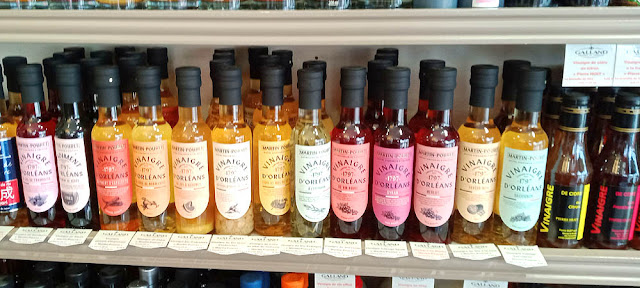Vinaigre d'Orléans (Orleans vinegar) is a wine vinegar made using an artisanal technique known as 'the Orléans method'.
It is obtained by naturally 'spoiling' already inferior quality wine so that acetic fermentation develops in a partially filled big oak barrel that is left in a well aerated cellar. After three weeks half the vinegar from the big barrel is tipped into a smaller barrel and the big barrel replenished. This process is repeated over the course of a year, concentrating the vinegar and developing its flavour compounds in a similar fashion to the way balsamic vinegar is made.
Vinegar production around Orléans dates back to the Middle Ages and it is mentioned in the City records in 1415. It was originally a drink, then a remedy and a condiment. Until the 14th century apothecaries and vinegar makers belonged to the same trade guild. Then in 1394 they were officially grouped with sauce, beverage and mustard makers. By 1594 production had increased so much that the City Aldermen drew up a code of quality in order to protect the reputation of their vinegar.
By 1778 there were 300 merchant-manufacturers and retailers who had the right to manufacture, sell and distribute vinegars. Virtually all French vinegar came from Orléans. The two most famous manufacturers are Martin Pouret, still manufacturing today, and Dessaux, which was purchased by Maillé when they wanted to control their own vinegar manufacture rather than buy from Pouret. The Dessaux building still exists in Orléans, but the brand does not. At the end of the 18th century there were 17 vinegar merchants in Orléans and 200 - 300 manufacturers. By 1830 there where 45 manufacturers and in 1851 there were 75 vinegar factories.
The wine used came from the Loire Valley and south-west of France and was about 10% alcohol by volume. Fifty litres of wine is put into a 240 litre barrel laid on its side and already containing fermenting vinegar. Mycoderma aceti, a bacteria naturally floating in the air, settles on the surface of the liquid and starts creating acetic acid. The barrel is kept half full and in a warm well ventilated cellar. After this process is complete half the liquid is transferred to small barrels which are kept in a cool cellar and the vinegar is allowed to mature for a year, after which it is filtered and bottled.
Unlike industrially produced vinegar, the Orléans artisan method uses natural surface fermentation and no acetic bacteria are added to accelerated the process, nor is the brew stirred. Each barrel produces 10 litres of vinegar for maturation a week.
In the 19th century vinegar made fortunes for men like Louis Auguste Pilté, who purchased the Chateau of Grillemont near La Chapelle Blanche Saint Martin in 1808. The reason was the location of manufacture, Orléans. Because of its positon on the Loire, Orléans was the closest practical port to Paris and allowed transport right across France, because unlike other major rivers, like the Seine, you could not just go downstream with the current but sail back upstream because the prevailing winds blew from the west. Tonnes barrels of wine arrived at Orléans from the west, and inevitably some of it spoiled in the barrel on the voyage (wine was stored and transported in barrels until the 20th century when it became more usual to transport it in bottles). So, vinegar production was opportunistically taken up.
Today, only Martin Pouret continues to use the old slow Orléans artisanal method of surface fermentation, at the same location as they started in 1797. Modern accelerated vinegar production, where the acid forming bacteria is added to the wine, allows for a finished product in 48 hours. Martin Pouret make flavoured vinegars, pickled gherkins and 100% French mustard (most 'French' mustard is made with imported mustard seed). It is sold in some supermarkets (eg Monoprix) and specialist grocers (the photo above was taken in Maison Galland in Amboise).


3 comments:
Have just bought Martin Pouret mustard here in Costa Rica.....in a shop resembling Noz.
Fly: That's the way to do it.
This is all new to me! I'm eager to try it, hopefully I can find it in Carpentras.
bonnie in provence
Post a Comment